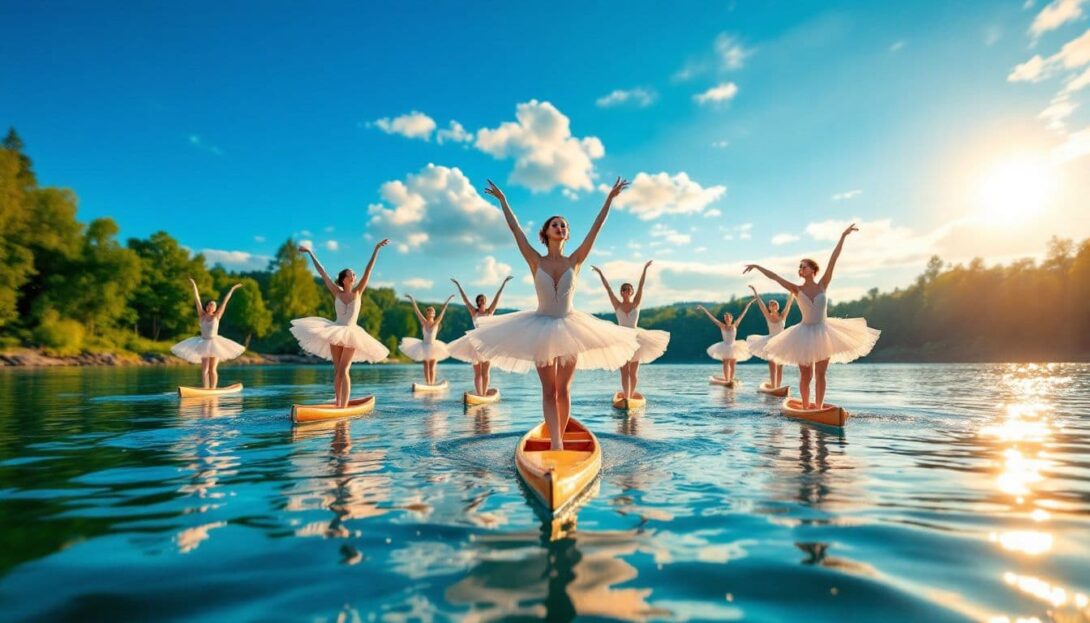Whether spinning on stage or paddling through waves, mastering balance improves your performance. This article explores the role of balance in ballet and canoeing and shares tips for enhancing stability.
Graceful Insights
- Achieving balance in ballet and canoeing requires precision, core strength, and upper/lower body engagement to enhance performance.
- Incorporating balance drills and core workouts into your training can improve stability and prevent injuries in both disciplines.
- Consistency and mental focus are vital for mastering balance techniques, leading to greater confidence and improved performance.
The Art of Balance: Ballet vs. Canoeing

Achieving good balance is like threading a needle; it requires precision and alignment. Maintaining balance is crucial in ballet for executing graceful movements and complex routines. Similarly, keeping the boat steady amidst natural forces ensures smooth paddling in canoeing.
Aligning the body’s vertical axis is vital for stability in ballet, enabling elegant and controlled performance. Canoeing also requires precise alignment, with the added challenge of water currents and wind. The design of canoes, including aspects like rocker, materials, length, and hull shape, significantly contributes to their performance and speed. Upper body muscles, including the biceps, triceps, chest, shoulders, and back muscles, are essential for paddle strokes, gripping the paddle, generating power, and maintaining balance.
Both ballet and canoeing demand a harmonious blend of strength and grace. Despite differing contexts, the underlying principles of balance are consistent. Recognizing these similarities helps us appreciate the art and science behind stability, whether on a dance floor or in a canoe.
Core Muscles: The Foundation of Stability in Ballet and Canoeing
At the heart of ballet and canoeing lies the core—the foundation of stability and control. In ballet, a strong core maintains a stable posture during intricate movements. Core muscles stabilize the body in canoeing and ensure efficient energy transfer with each paddle stroke.
A robust core stabilizes the spine, minimizing injury risk and enabling confident, precise performance for dancers and paddlers. Core strength isn’t just about aesthetics; it’s about executing precise movements in ballet and effective paddling in canoeing. Dynamic core workouts enhance these stabilizing muscles, improving overall balance and performance.
Incorporating core exercises into your routine builds a strong foundation for ballet and canoeing. This approach enhances performance and helps prevent injuries, ensuring you can handle the physical exertion of these activities.
Mastering Torso Rotation
Torso rotation is a vital component of efficient paddling. It enables paddlers to generate power and speed while maintaining balance and control. Effective torso rotation involves the coordinated movement of the upper body, core muscles, and back muscles to produce a fluid motion. This fluid motion is essential for maintaining forward momentum and ensuring that each paddle stroke is powerful and efficient.
To master torso rotation, paddlers must develop good posture, engage their core muscles, and practice paddle strokes that promote efficient power transfer. A strong upper body, particularly the muscles of the back and shoulders, is essential for maintaining balance and generating forward momentum. Paddlers can improve their torso rotation by practicing exercises that target the core muscles, such as planks, crunches, and twists. Additionally, activities that promote flexibility and range of motion, such as yoga, Pilates, or dynamic stretching, can be highly beneficial.
As a ballet dancer, Todd Fox emphasizes the importance of torso rotation in paddling, highlighting its role in maintaining balance and generating power. By incorporating torso rotation exercises into their training routine, paddlers can improve their overall performance, reduce the risk of injury, and enhance their cardiovascular health. It’s essential to maintain a stable and balanced position when paddling, with the torso rotating in harmony with the paddle strokes.
By mastering torso rotation, paddlers can achieve a full-body workout, engaging multiple muscle groups and improving their physical exertion. In a short period, paddlers can develop the skills and strength needed to master torso rotation, leading to enhanced paddling efficiency and overall performance. When interacting with other paddlers, it’s essential to maintain a respectful distance and be mindful of their paddle strokes, avoiding collisions and promoting a safe and enjoyable paddling experience.
Paddlers can improve their paddle stroke by focusing on torso rotation, increasing efficiency, and reducing fatigue. A canoe or kayak with a well-designed paddle can help paddlers maintain a comfortable and efficient paddling position, promoting good posture and reducing strain on the back muscles. Canoeing and kayaking are excellent ways to improve cardiovascular health, build strength, and enhance overall fitness, making them ideal activities for those seeking a full-body workout.
It’s essential to maintain a stable and balanced position when paddling, with one leg slightly bent and the other straight. This promotes good posture and reduces strain on the back muscles. By incorporating torso rotation exercises into their training routine, paddlers can improve their overall performance, reduce the risk of injury, and enhance their cardiovascular health. A strong core and good posture are essential for maintaining balance and generating power while paddling, making torso rotation a critical component of efficient paddling.
Paddlers can improve their torso rotation by practicing exercises that target the core muscles, such as planks, crunches, and Russian twists. By mastering torso rotation, paddlers can achieve a full-body workout, engaging multiple muscle groups and improving their physical exertion.
Upper Body Strength: Supporting Balance and Control
Upper body strength is the unsung hero in both ballet and canoeing. Shoulders, arms, and chest muscles significantly maintain balance and control. In canoeing, these muscles power the strokes that propel the boat forward, directly affecting stability on the water.
In ballet, the upper body aids a ballet dancer in achieving balance and executing movements gracefully. Strong shoulders and arms support posture, while a well-developed chest ensures control.
Focusing on upper body exercises enhances strength, making it easier to maintain balance and perform with precision in both disciplines.
Lower Body Engagement: Power and Precision
A stable base is critical for generating force and maintaining balance in ballet and canoeing. Legs, hips, and feet provide the power and precision needed to excel. In ballet, recovering from imbalance relies on muscle power and quick force exertion. Similarly, quadriceps and hamstrings are essential for maintaining balance and preventing capsizing in canoeing.
Glute muscles significantly contribute to hip stability and force generation, enhancing overall paddling performance. Engaging lower body muscles is key to maintaining stability and performing with power, whether executing a pirouette or navigating choppy waters.
Focusing on lower body engagement improves your ability to generate force efficiently, making it easier to perform complex movements in ballet and handle the physical demands of canoeing.
Techniques for Enhancing Balance

Improving balance is a continuous journey involving various exercises and techniques. Maintaining a stable posture and engaging the right muscle groups in ballet and canoeing enhance balance. Exercises that promote posture and stability, such as those involving uneven surfaces, can significantly improve balance.
Regularly practicing balance drills, especially those challenging proprioception and core engagement, leads to better performance in both disciplines. Mind-body exercises like Tai Chi can enhance overall stability by engaging the mind and body.
Standing Exercises
Standing exercises target muscle groups essential for maintaining balance. Focusing on the legs and core significantly improves stability and overall performance. For example, standing on a wobbleboard challenges your body’s balance through controlled rocking movements.
Incorporating these exercises into your routine develops the strength and stability needed for ballet and canoeing. Whether standing on one leg or practicing controlled movements, these exercises enhance your ability to maintain balance and perform with precision.
Fluid Motion Drills
Fluid motion is crucial for balance and coordination in ballet and canoeing. For instance, rotating movements on a wobble board promote ankle flexibility and overall coordination, enhancing fluid performance.
Drills focusing on fluid motion improve coordination and enhance movement fluidity. Regularly incorporating these drills can significantly improve performance in both disciplines.
Core Workouts
Core workouts enhance stability and control, benefiting both ballerinas and canoeists. Incorporating breathing techniques during these workouts significantly improves muscle engagement and stability. Enhanced core stability leads to better balance and overall performance in both ballet and canoeing.
Regular core workouts increase control and stability, making it easier to perform complex movements and handle the physical demands of both disciplines.
Mental Focus and Coordination

Mental focus is crucial in both ballet and canoeing. Enhanced mental fitness, involving cognitive processes like decision-making and reaction time, is vital for balance. Drills focusing on fluid motion enhance coordination, which is essential for performance in both disciplines.
Coordination involves synchronizing movements, which is crucial for achieving balance in ballet and canoeing. Mental rehearsal of movements significantly improves performance through sequence visualization. Developing mental focus and coordination enables athletes to execute complex techniques more effectively and maintain stability.
Benefits of Improved Balance

Improving balance offers numerous benefits, from reducing injury risk to enhancing physical performance. Greater body stability is essential for ballet dancers and canoeists, allowing for more controlled and precise movements.
Incorporating balance techniques into your routine significantly improves performance in both disciplines. Focusing on maintaining balance and good posture leads to better results and offers physical and mental benefits.
Tips for Consistent Practice
Consistency is key to improving balance. Standing exercises with slight knee and hip flexion improve posture and balance. Regularly practicing balance routines solidifies the integration of balance systems in the body, leading to more consistent performance.
Engaging in mindfulness enhances mental focus, benefiting performance in ballet and canoeing. Incorporating cross-training strengthens muscles essential for achieving speed and precision in balance training. Breaking down complex movements into individual components helps master skills before increasing speed.
Resume
Balancing and canoeing require a harmonious blend of strength, balance, and mental focus. Understanding the similarities and differences between these disciplines can enhance your skills and stability in both. Incorporating these techniques into your routine, whether through core workouts, standing exercises, or fluid motion drills, will help you achieve better balance and performance.
Embrace the journey of finding balance in ballet and canoeing, and let the principles of stability and control guide you to new heights. With consistent practice and a focus on mental and physical fitness, you can excel in both disciplines and enjoy their many benefits.



